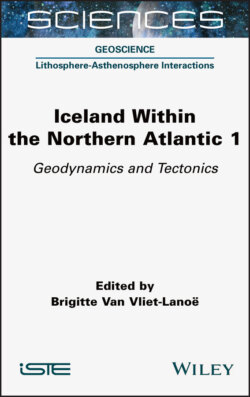Iceland Within the Northern Atlantic, Volume 1

Реклама. ООО «ЛитРес», ИНН: 7719571260.
Оглавление
Группа авторов. Iceland Within the Northern Atlantic, Volume 1
Table of Contents
List of Illustrations
List of Tables
Guide
Pages
Iceland Within the Northern Atlantic 1. Geodynamics and Tectonics
List of Abbreviations
A
B
C
D
E
F
G
H
I
J
K
L
M
N
O
R
S
T
U
W
Preface
Introduction
1. Iceland, in the Lineage of Two Oceans
1.1. Geographic and geodynamic context
1.2. Components of the North Atlantic domain
1.2.1. The Mid-Atlantic Ridge
1.2.2. The North Atlantic Igneous Province
1.2.3. The Icelandic hot spot
1.2.4. The Greenland–Iceland–Faroe Ridge
1.3. Geodynamic characteristics of Iceland
1.3.1. Seismicity
1.3.2. Icelandic volcanism
1.3.3. Eustatism and the Icelandic glaciers
1.4. References
2. Iceland, an Emerging Ocean Rift
2.1. Mid-Atlantic Ridge and Icelandic hot spot interactions
2.2. Present-day deformations in Iceland
2.2.1. Seismicity
2.2.1.1. Seismicity of volcanic zones
2.2.1.2. Seismicity and tectonics
2.2.1.2.1. Seismicity of the TFZ
2.2.1.2.2. Seismicity of the SISZ and Reykjanes Peninsula
2.2.1.3. Interaction between glaciation, tectonics and seismicity
2.2.2. Motions at plate boundaries
2.3. Iceland’s main structural features
2.3.1. The paleo-rifts and the active rift. 2.3.1.1. The paleo-rifts
2.3.1.2. The active volcanic zones
2.3.1.2.1. Meaning of “flank zones”
2.3.1.2.2. Special features of the active rift
2.3.1.2.3. Structures of the active rift
2.3.2. The transform zones
2.3.2.1. The Tjörnes Fracture Zone
2.3.2.1.1. Lineaments of the TFZ
2.3.2.1.2. Deformation partitioning in the TFZ
2.3.2.2. The South Iceland Seismic Zone
2.3.2.2.1. Structures of the SISZ
2.3.2.2.2. Historical seismic faults
2.3.2.2.3. Models for the SISZ
2.3.2.3. Comparison of the two transform zones in terms of geometry and stress state
2.4. Geothermal energy and hydrothermalism. 2.4.1. Geothermal systems
2.4.2. Geysers and hydrothermalism
2.5. References
3. Iceland, a Legacy of North Atlantic History
3.1. Bathymetry of the Northeast Atlantic domain and geoid anomalies
3.2. The North Atlantic and the continental breakup of Laurussia
3.2.1. Passive margins and large igneous provinces
3.2.2. The early beginnings of the opening of the North Atlantic Ocean. 3.2.2.1. Magnetic anomalies, magnetochrons and types of lithosphere
3.2.2.2. Evolution in West Greenland
3.2.2.3. Evolution in East Greenland: a mobile region since the Paleozoic
3.2.3. Thulean magmatism in the Paleocene and the continental breakup of the Northeast Atlantic. 3.2.3.1. Thulean traps
3.2.3.2. Paleogene syn-magmatic breakup
3.2.4. Chronology and kinematics of the opening of the Northeast Atlantic. 3.2.4.1. Age of onset of oceanization in the northeast Atlantic
3.2.4.2. The ocean basins of the Northeast Atlantic
3.2.4.3. The Reykjanes Basin in Southern Iceland
3.2.4.4. The GIFR ridge
3.2.4.5. The extinct Ægir Ridge
3.2.4.6. The Jan Mayen microcontinent and the Kolbeinsey Basin
3.2.5. The Northeast Atlantic region: mantle plume or not?
3.2.5.1. The Icelandic hot spot
3.2.5.2. The mantle plume hypothesis
3.2.5.3. Arguments against the mantle plume model
3.3. The origin of Iceland. 3.3.1. The anomalous crust of the GIFR ridge and the deep structure of Iceland
3.3.2. Icelandic SDRs
3.3.3. Interpretations of GIFR and Iceland
3.3.3.1. The pattern of plate movement over a hot spot
3.3.3.2. A continental axis stretched between Greenland and Europe?
3.4. References
Conclusion
A long and complex history
Plume or no plume, that is the question
An oceanic rift with special characteristics
A still mysterious island
References. Key books
Articles, documents and key theses
Websites
List of Authors
Index. A, B
C
D
E
F
G
H
I
K, L
M
N, O
P
Q, R
S
T
U, V, W
Summary of Volume 2
WILEY END USER LICENSE AGREEMENT
Отрывок из книги
Geoscience, Field Director – Yves Lagabrielle Lithosphere-Asthenosphere Interactions, Subject Head – René Maury
.....
The development of radiometric dating (section 2.4 of Volume 2) allowed us to better constrain both the chronology of the progressive extinction of the paleorifts and also that of the glaciations with respect to the tectonic and paleo-oceanographic evolution of the North Atlantic. The impact of the glacial loading of rifts during periods of extended ice caps could explain pro parte this cyclic evolution linked to rift-jump.
.....